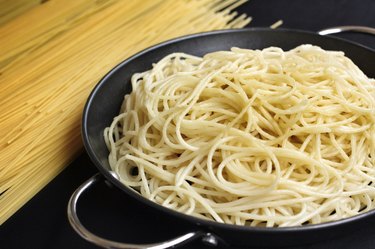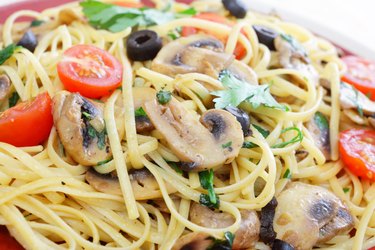
When determining the serving size of any food, including spaghetti noodles, it is important to check the packaging. The U.S. Food & Drug Administration requires a nutrition facts label on most commercial food product packaging that specifies how many servings are contained in each package, as well as how large an appropriate serving size is. Paying attention to the package information can help you make good nutritional choices.
Spaghetti Serving Size
Video of the Day

According to the U.S. National Library of Medicine (NLM), the serving size for spaghetti noodles is usually 2 ounces of uncooked noodles, or 1 cup of cooked pasta. Look at the packaging to be sure. Remember that if you eat a bowl full of pasta without measuring, you may be consuming two or more servings, essentially doubling the calories, fat and carbohydrates that you would eat if you had eaten one serving.
Video of the Day
Measuring or Estimating a Serving

You can estimate the amount of spaghetti that you put in your bowl, or you can use a measuring cup for a more accurate assessment of what you are eating. To guess how much pasta you have in front of you, the Dairy Council of California suggests thinking of a rounded handful as approximately 1/2 cup. Two rounded handfuls would equal about a cup, or one serving, of noodles. Another way to estimate is to measure out 1 cup of cooked pasta and to determine how much room it takes up in the bowl or on the plate. Keep the visual picture in mind for future meals.
Nutritional Benefits of Spaghetti

Spaghetti noodles can be a beneficial part of your diet. Since most people should get about 2/3 of their calories from carbohydrates, whole wheat noodles can help with that goal. Pasta does not contain cholesterol, and the whole wheat version is a source of dietary fiber, says the NLM. Enriched pasta contains folic acid, a vital nutrient for women of childbearing age, and little sodium.
Misconceptions About Carbs

Some people think that drastically reducing carbohydrates and avoiding foods like spaghetti can help them lose weight. Although reducing calories can help with your weight-loss goals, adding pasta to your diet can help you lose weight too. Another misconception is that pasta is a simple carbohydrate, whereas whole wheat pasta is in fact a complex carbohydrate that can not only sustain your energy level but also has a low glycemic index, helping to keep your blood sugar levels in check.
Spaghetti Serving Tips

What you serve with your spaghetti noodles makes a big difference in the nutritional value of the meal. Jarred spaghetti sauces often contain a lot of sodium and sugars, negatively affecting the healthfulness of your noodles. Creamy Alfredo sauces contain fat that you may not want in your diet. Serving your pasta with fresh vegetables, poultry or grilled tofu, and a drizzle of olive oil can make for a heart-healthy, diet-friendly meal. Another option is to make your own tomato sauce with fresh or no-salt-added canned tomatoes and fresh or dried seasonings.